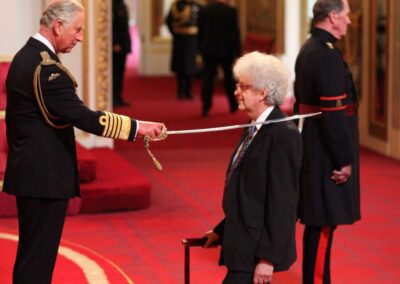
How To Use Bureaucracies
This is an excerpt from the draft of my upcoming book on great founder theory. Learn more here.
When we encounter unsavory features of reality, it can be tempting to look away. Instead, we should ask, “What purpose does this serve?” With this in mind, let’s look at bureaucracies. Some people fear bureaucracies; they fear “the Machine.” Others are bothered by the bureaucracies’ apparent dysfunction. With a better understanding of bureaucracies — what they are, why they’re here, and how they work — both of these responses evaporate, because the reality is this: bureaucracies aren’t altogether bad. In fact, bureaucracies can be incredibly useful.
What is a bureaucracy?
A bureaucracy is an automated system of people created to accomplish a goal. It’s a mech suit composed of people. The owner of a bureaucracy, if an owner exists, is the person who can effectively shape the bureaucracy. Bureaucrats are the people who are part of a bureaucracy (excluding the owner).
Not all organizations are bureaucracies. Most organizations are mixed — they have both bureaucratic and non-bureaucratic elements. The purpose of a bureaucracy is to save the time of a competent person. Put another way: to save time, some competent people will create a system that is meant to do exactly what they want — nothing more and nothing less. In particular, it’s necessary to create a bureaucracy when you are both (a) trying to do something that you do not have the capacity to do on your own, and (b) unable to find a competent, aligned person to handle the project for you. Bureaucracies ameliorate the problem of talent and alignment scarcity.
Bureaucrats are expected to act according to a script, or a set of procedures — and that’s it. Owners don’t trust that bureaucrats will be competent or aligned enough to act in line with the owner’s wishes of their own accord. Given this lack of trust, owners should be trying to disempower bureaucrats. Bureaucracies are built to align people and make them sufficiently competent by chaining them with rules. When bureaucracies deliberately restrict innovation, they are doing it for good reason.
Bureaucrats are meant to have only borrowed power (power that can easily be taken away) given to them by the owner or operator of the bureaucracy.
Effective Bureaucracies
What is an effective, owned bureaucracy? Why are effective bureaucracies owned? To begin, we must make two important distinctions: one between owned and abandoned bureaucracies, and one between effective and ineffective bureaucracies.
Owned bureaucracies are bureaucracies with an owner; they’re bureaucracies that someone can shape.
Abandoned bureaucracies are bureaucracies without an owner. If a bureaucracy is owned, the bureaucracy’s owner is likely the bureaucracy’s creator. The creator will have knowledge about the setup of the bureaucracy that is necessary for properly reforming it. Others, unless given this information, will not understand the bureaucracy well enough to properly reform it.
The person technically in charge of the bureaucracy (e.g. the C.E.O. of a company who is not its founder) might not be its owner simply because he or she doesn’t have sufficient information about the bureaucracy’s setup to guide it. As a result, the official head of a given bureaucracy may just be another bureaucrat.
While the owner is typically the creator, this needn’t be true, as long as the new owner has come to understand enough of the function of the bureaucracy to make effective adaptations to its procedures.
Effective bureaucracies are bureaucracies that are handling the project they were created to handle. Ineffective bureaucracies are bureaucracies that are not handling the project they were created to handle.
Bureaucracies that are properly set up will be effective at the start. Changes in reality require changes in procedures, however, so a bureaucracy’s procedures inevitably need to be altered appropriately for it to remain effective. Over time, abandoned bureaucracies, having no person who can functionally shape the bureaucracy to make these changes, quickly become ineffective bureaucracies.
Owned bureaucracies, on the other hand, have a shot at making these adaptations to prevent decay. If the owner is skilled, the bureaucracy’s procedures can be modified, and the bureaucracy will continue serving its original purpose. If the owner is unskilled, it is as if the bureaucracy is abandoned—the owner’s efforts to change the bureaucracy’s strategies won’t yield successful adaptation, and the bureaucracy will become ineffective. As a result, for a bureaucracy to remain effective over time, it must be an owned, not abandoned, bureaucracy with a sufficiently capable owner.
Losing and Dismantling Bureaucracies
Bureaucracies are best thought of as an extension of their creator and as a source of power for him or her. However, the owner can lose control of the bureaucracy over time, as bureaucrats convert borrowed power into owned power by exploiting information asymmetries. While owners will try to limit the owned power of their bureaucrats, the bureaucrats will have more than enough time to study the instruments of their control and will learn what is rewarded and what isn’t.
Imagine a bureaucrat who is supposed to be an assistant to the absentee owner of an institution. This senior assistant is supposed to research solutions to key problems, and then present several options to the owner, who then selects one. The assistant is then required to implement the one that was chosen. There is a very detailed document describing their job and requirements at every step of this process.
The key problem is that a very complex set of rules can be easily bent to achieve an arbitrary outcome. The outcome will be completely valid according to the rule set. This is analogous to how in science a very complex model, that fits the data, is not very impressive. As Von Neumann put it: “With four parameters I can fit an elephant, and with five I can make him wiggle his trunk.” Let’s walk through the described process the senior assistant is supposed to follow to demonstrate how bureaucrats wiggle their trunks.
You might require the assistant to not engage in original research, but rather work as a search engine through more objective academic literature or best practices in a particular industry. The assistant, however, can cherry pick seemingly objective academic papers to argue for their preferred policy outcome. It is actually much easier to start with a preconceived opinion and then find work confirming it, rather than review a literature as a whole. The plausibility of this shortcut should be intimately familiar to any university student who has worked under the pressure of a deadline for a class paper they didn’t much care about.
The chief assistant can craft several options. They can make option B, their favorite, the most appealing, and cripple options A and C. Maybe even include point 14, their core agenda, in all three of their proposals that vary on points 1 to 13 which they don’t much care about. Whatever the implementation of the selected solution is, the letter of the law can be bent and can easily diverge from the spirit of the law.
In such a circumstance, an owner can lose control of the bureaucracy and the power that comes with it.
It is often beneficial for owners to dismantle bureaucracies after they have served their purpose to avoid losing ownership of them due to these information asymmetries. Bureaucracies of this type might grow to be independent powers that interfere with your plans. While it may sound inconceivable for a bureaucracy to be intentionally dismantled today, many secret police forces throughout history have been so dismantled, including the famous Praetorian Guard of ancient Rome. It is not that bureaucracies are inherently impossible to dismantle that causes this perception, rather that we suffer a shortage of owners for bureaucracies today.
Abandoned bureaucracies might also be viable targets for outside takeover. Such takeovers can be a serious problem if undertaken by your opposition. Bureaucracies nearly always carry a heavy legacy document footprint; when examined this footprint can not only produce, but also be used to carry out legal or PR attacks. If the institution is vested with the authority or reputation of its original owner, these attacks can also be turned against them.
If it is too hard to regain ownership, dismantling the institution for resources may be the best option. These resources might be quite easily quantifiable, such as real estate or key employees. They might also be less tangible, such as the attention of your allies. Unless you formally retire a vehicle, these allies might mistakenly believe it active, causing communication issues or misunderstandings of your key priorities.
In short, when handling multiple organizations, tying up loose ends becomes very important.
How to accomplish tasks in an institutional landscape
Building a bureaucracy is an effective way to accomplish your goals under the right circumstances, but it’s not the best option. In order of effectiveness, here are general options for getting things done:
Delegate
If you can find a competent, aligned person who will do the project in question for you — let’s call them a delegate — then let them do it. This person can create a bureaucracy for you, if necessary, as projects of a certain scale will require bureaucratization. Unfortunately, because of the harsh talent and alignment scarcity mentioned earlier, finding delegates can be challenging. Furthermore, correctly assessing whether someone is a worthy delegate takes skill. Frequently people will accidentally delegate a project to someone who is insufficiently competent or aligned. Failed delegation is worse than building your own bureaucracy, because it will lead to project failure.
If you have access to a delegate, don’t treat them like a bureaucrat. This wastes a valuable resource: a delegate can perform tasks you didn’t know needed doing and build aligned systems beyond your design; a bureaucrat cannot.
Such treatment invites misalignment with your delegate. It isn’t just a matter of interpersonal grace and respect, so it cannot be overcome with kindly management; rather if you are attempting to closely proceduralize the actions of a competent delegate, they might accurately conclude that the best way to perform their job is to attempt to bypass your control. If you picked them well, they will be rather effective in doing so. They don’t need a script — if they’re competent enough for your purposes, they’ll be able to figure out how to do the project.
Give them owned power, otherwise you might run them off.
Bureaucratize
If you can’t find a delegate, then building your own bureaucracy (even if it’s small) is the best bet. Bureaucratizing some things and not others, on the basis of whether the task can be proceduralized, is typically more effective than bureaucratizing everything by default. Figure out when using an automated system is the best option.
Do it yourself
While doing it yourself may be most likely to result in a well run project, it is not always feasible — you have limited time and capacity. Without delegates or bureaucracies, the ambitiousness of the projects you can successfully execute will be bounded.
Don’t do it
Some things, though useful, aren’t worth doing…
How to Assess People and Organizations
Assessing People
An understanding of bureaucracies lets you analyze a given person’s power: is someone acting as a delegate or a bureaucrat? Is someone creating delegates or bureaucrats? If someone has created a bureaucracy, do they understand the function of bureaucracies? Do they own their bureaucracy, or is it abandoned? If they own their bureaucracy, is it effective or ineffective? Are they creating bureaucracies under the right conditions? What is the role of bureaucracies in their plan?
If a person is powerful, what does it mean if he’s created many bureaucracies? In some cases, the creation of many bureaucracies indicates that the owner is extremely good at building automated systems. Alternately, he might have trouble delegating — perhaps because he can’t find competent, aligned people, or because he can’t assess people well. People who can work well with others and have access to sufficiently talented aligned people need fewer bureaucracies. Instead, they’ll delegate to others, who can either do the project themselves or create a bureaucracy of their own.
On the other hand, if a person is powerful, what does it mean if he’s created few or no bureaucracies? If he isn’t delegating, it means that he’s doing everything himself and possibly doesn’t know how to design automated systems. If he is delegating, he’s likely to be good enough at finding competent, aligned people such that he doesn’t need a bureaucracy. Powerful people who don’t create bureaucracies can be just as powerful as people who do.
Assessing Organizations
The framework can be applied to evaluating organizations. For a given organization, begin by asking if it’s a bureaucracy. If it is, expect it to behave in highly stereotyped ways: it will not be very adaptive to new challenges and will not accurately evaluate things outside the assumed ontology of its paperwork and internal division of labor.
If it’s a bureaucracy, we can ask: is it an owned or an abandoned bureaucracy? If it is owned, expect that a large enough challenge will eventually cause it to reorganize. You’ll also be able to reach out to the owner to resolve problems or find a way to cooperate that the bureaucracy itself doesn’t understand.
Is it an effective or ineffective bureaucracy? If it is effective, you can rely on the interface it offers you to achieve the goal it claims to achieve. Ineffective ones will provide a sometimes bewildering service that might only tangentially be related to their efforts. Remember that not all organizations are bureaucracies.
Some non-bureaucratic institutions will have to pretend they are bureaucracies on paper for legal compliance. This is an example of a more general principle: independent organizations interpret externally imposed regulation as damage, and route around it.
Organizations can be tightly coordinated groups that feature a lot of delegation and deference. In these, expect adaptive behavior; the ontology they are working in might rapidly change to respond to either your challenge or offer of cooperation. Most importantly there will be individuals beyond just the leader who can exercise their own judgement.
Effectively Interacting with Existing Organizations
If an organization is not a bureaucracy, but rather a tightly coordinated group, talk to the delegates if you want to get things done; they will have freedom to act competently within their own domain and will be easier to reach than leadership.
The key advantage of talking to people over engaging with automated systems is that you can bring considerations from outside their immediate institutional context into consideration. While the local balance of power might still be in the way of such considerations, it is surprisingly often viable to have them taken into account.
If it’s a bureaucracy, you can either (1) go along with it, (2) figure out how to bypass it, or (3) coordinate with its owner, if it is owned. You may prefer to bypass (or game) the bureaucracy if it is abandoned and thus dysfunctional, or if you aren’t aligned with its owner.
The Value of Bureaucracy
The origin of bureaucracies lies in their extension of power and results far beyond what a single individual can do. They can do so in the absence of expensive and difficult coordination, or individual talent that is difficult to train and evaluate.
Much like factories can produce cheap products at scale with unskilled labor, displacing craftsmen, so have bureaucracies displaced local social fabric as the generators of social outcomes.
We find ourselves embedded in a bureaucratized landscape. What can or cannot be done in it is determined by the organizations composing it. The constant drive by talented individuals to both extend power and make do with unskilled white-collar labor (a category that economists should recognize and talk more about) has littered the social landscape with many large organizations. Some remain piloted, others are long abandoned. Some continue to perform vital social functions, others lumber about making life difficult.
Much as we might bemoan the very real human cost bureaucracies impose, they currently provide services at economies that are otherwise simply not possible. We must acknowledge our collective and individual dependence on them, and plan to interact accordingly.




